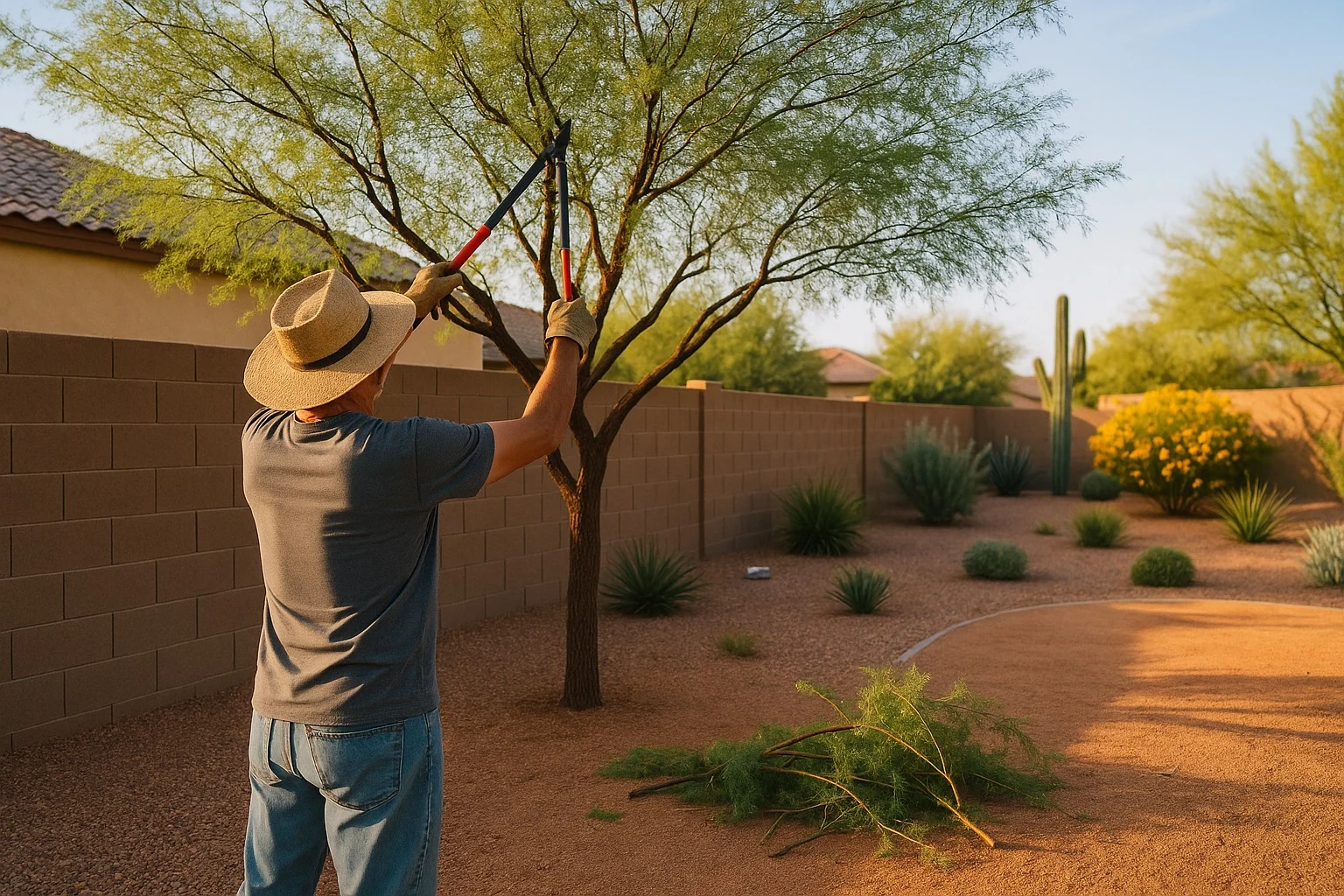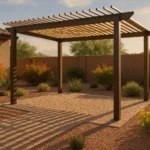Desert trees in Gilbert require specialized care to thrive in our unique climate. With temperatures regularly climbing above 100°F in summer and minimal rainfall throughout the year, proper pruning becomes essential for maintaining healthy, attractive trees. Whether you’re looking to improve your property’s curb appeal or ensure your trees’ long-term health, dedicating a weekend to strategic pruning can yield impressive results. These weekend tree pruning projects are perfectly suited for Gilbert’s desert environment and can be completed in just a day or two.
Why Weekend Pruning Projects Matter for Gilbert Trees
Desert trees have adapted to survive harsh conditions, but urban landscapes present different challenges than their native habitats. In Gilbert’s residential areas, trees often receive supplemental irrigation and grow in modified soil conditions, which can lead to faster growth patterns requiring more frequent maintenance. Weekend pruning projects allow homeowners to address specific tree issues without becoming overwhelmed by tackling everything at once.
Regular pruning helps desert trees develop stronger structures that can withstand our seasonal monsoon winds and occasional storms. It also prevents overgrowth that can interfere with power lines, structures, or block critical views for traffic safety. For many Gilbert residents, dedicating a single weekend every few months to focused pruning tasks keeps trees manageable while improving their overall health and appearance.
Additionally, properly timed weekend pruning projects reduce stress on trees by addressing issues during optimal seasons. For instance, major structural pruning of most desert trees should be completed during winter dormancy, while light maintenance pruning can be performed year-round with proper precautions. By breaking tree care into manageable weekend projects, you can ensure each tree receives attention at its ideal pruning time.
Essential Tools for Weekend Desert Tree Pruning
Before beginning any weekend pruning project in Gilbert, gathering the right tools is crucial for both safety and efficiency. For small branches up to ¾ inch in diameter, quality bypass hand pruners provide clean cuts that heal quickly. Loppers extend your reach and cutting capacity for branches up to 2 inches thick. For higher branches, a pole pruner can safely access heights of 8-12 feet without requiring a ladder, which is particularly useful for desert trees with thorns like mesquite or acacia.
Larger branches may require a pruning saw, and a folding model offers convenience for weekend projects. For significant pruning of mature trees, consider renting a chainsaw for the day—just ensure you’re comfortable with its operation or hire a professional. Don’t forget protective equipment: sturdy gloves are essential when working with thorny desert species, and safety glasses protect your eyes from falling debris. Long sleeves and pants provide additional protection against scratches and sun exposure during your weekend project.
Maintaining your tools between pruning sessions ensures they’ll be ready for your next weekend project. Clean blades with rubbing alcohol or a 10% bleach solution between trees to prevent disease transmission. Keep cutting edges sharp for cleaner cuts that heal faster. Quality pruning tools are an investment that will serve you through many weekend projects, so choose durable options designed for desert conditions where sap and hard wood can quickly dull inferior blades.
Weekend Project #1: Structural Pruning of Young Desert Trees

Dedicating a weekend to structural pruning of young desert trees is perhaps the most valuable investment in your Gilbert landscape. Trees under five years old benefit tremendously from early structural training that establishes strong branch architecture. Begin by identifying competing leaders (multiple upright stems) and select the strongest, most centered one to become the main trunk. Remove or shorten competing leaders to encourage a single dominant trunk. This weekend project prevents future problems like weak crotch angles that can split during Gilbert’s summer monsoon storms.
Next, focus on spacing permanent branches properly. Young desert trees often produce branches too close together, creating future crowding issues. Select branches that are spaced 8-12 inches apart vertically and emerge from the trunk at different points around its circumference. Remove branches that emerge directly opposite each other, as these create structural weaknesses. For desert species like palo verde or mesquite, which naturally grow with multiple trunks, select 3-5 main stems with strong attachments and remove the rest to prevent overcrowding.
Finally, address branch angles during this weekend project. Branches with narrow, V-shaped attachments to the trunk are prone to breaking, while those forming wider, U-shaped connections are stronger. For branches with potential, you can sometimes widen their angle by using spreaders (small pieces of wood) to push them away from the trunk temporarily. This single weekend of careful structural pruning on young trees prevents years of problems and reduces the need for major corrective pruning later, which is particularly important for fast-growing desert species in Gilbert’s climate.
Weekend Project #2: Clearing the Canopy Interior
A weekend dedicated to thinning the interior canopy of mature desert trees improves both health and appearance. Desert trees like mesquite and palo verde often develop dense interior growth that restricts air circulation and light penetration. This weekend project focuses on selectively removing crossing, rubbing, or inward-growing branches to create a more open structure. Begin by stepping back and assessing the tree’s overall form, identifying congested areas that would benefit from selective thinning. The goal isn’t to remove a specific percentage of growth but rather to create space between remaining branches.
Work methodically from the inside out, removing the smallest branches first. This approach maintains the tree’s natural form while improving its structure. Target water sprouts (fast-growing vertical shoots) that emerge from main branches, as these rarely develop into useful structural limbs. For desert trees like palo verde that photosynthesize through their green bark, avoid excessive thinning that might reduce their energy production capacity. Instead, focus on removing only problematic branches that cross or rub against others, potentially creating wounds that invite pests common to Gilbert’s desert environment.
After completing the interior thinning, step back frequently to assess your progress. The finished tree should maintain its natural shape while appearing more refined and less cluttered. This weekend project is particularly valuable before Gilbert’s monsoon season (June-September), as a properly thinned canopy offers less wind resistance during storms. Additionally, improved air circulation reduces fungal disease pressure during periods of higher humidity. For many Gilbert homeowners, this single weekend project dramatically enhances the appearance of mature desert trees while supporting their long-term health.
Weekend Project #3: Lower Limb Elevation
Dedicating a weekend to raising the canopy of desert trees creates usable space beneath them and enhances your Gilbert property’s functionality. Lower limb elevation involves selectively removing branches to establish a consistent clearance height. For trees along walkways, aim for 7-8 feet of clearance to allow comfortable pedestrian passage. Trees over driveways or streets benefit from 12-14 feet of clearance to accommodate vehicles. This weekend project transforms the usability of your outdoor space while maintaining the tree’s natural form and necessary shade coverage, which is particularly valuable in Gilbert’s hot climate.
When elevating the canopy, proper technique prevents unnecessary stress on desert trees. Always cut back to a larger parent branch or the trunk rather than leaving stubs. For larger limbs, use the three-cut method: make an undercut a foot from the trunk, followed by a top cut slightly further out to remove the bulk of the limb, and finally a precise cut at the branch collar to remove the remaining stub. This prevents bark tearing and promotes faster wound closure. Remember that desert trees like palo verde and mesquite heal more slowly than deciduous trees, making clean cuts particularly important.
Balance is key when elevating desert tree canopies during your weekend project. Avoid removing too many lower branches at once, as this can stress the tree and reduce its stability. A good rule for Gilbert’s desert species is to maintain living branches on at least the upper two-thirds of the tree’s height. This preserves sufficient foliage for photosynthesis while creating usable space beneath. For multi-trunked desert trees, selective removal of entire low stems may be more effective than raising all stems equally. After completion, your elevated tree canopy will provide shade at a comfortable height while allowing better visibility and movement throughout your Gilbert landscape.
Weekend Project #4: Citrus Tree Maintenance Pruning
Gilbert’s climate is ideal for citrus trees, and dedicating a weekend to their specialized pruning needs keeps them productive and healthy. Unlike native desert trees, citrus requires a different approach focused on maintaining fruit production rather than adapting to drought. Begin your weekend project by removing all suckers—vigorous vertical shoots that emerge from the rootstock below the graft line. These divert energy from fruit production and, if allowed to grow, will produce fruit different from the grafted variety. Use hand pruners to cut suckers flush with the trunk, checking for regrowth every few months.
Next, address dead or diseased wood, which is particularly important for citrus health in Gilbert’s occasional frost events. Remove any branches showing signs of citrus greening, canker, or frost damage, cutting back to healthy wood. Thin interior growth selectively to improve air circulation and light penetration, which reduces disease pressure and enhances fruit ripening. Unlike some fruit trees, citrus does not require heavy annual pruning—remove no more than 20% of the canopy in your weekend project to avoid stimulating excessive vegetative growth at the expense of fruit production.
Finish your citrus pruning weekend by addressing height control if needed. Citrus trees in Gilbert can grow quite tall if left unpruned, making harvesting difficult. To maintain a manageable height, identify the tallest branches and cut them back to outward-facing lateral branches. This technique, called “drop-crotching,” reduces height without creating unsightly stubs or stimulating excessive upright growth. Schedule this weekend project for late winter after frost danger has passed but before the spring growth flush begins—typically February in Gilbert. Avoid pruning citrus during summer months when sunburn risk is highest on newly exposed branches.
Weekend Project #5: Storm Damage Prevention Pruning
Gilbert’s summer monsoon season brings powerful winds and sudden downpours that can damage unprepared desert trees. Dedicating a weekend to preventative pruning before storm season significantly reduces risk to both trees and property. Begin by identifying and removing dead branches, which are the first to fail during high winds. Thoroughly inspect the canopy for branches showing signs of decay, insect damage, or previous partial breakage. These compromised limbs pose the greatest hazard during storms and should be prioritized in your weekend pruning project.
Next, assess the overall canopy density and balance. Desert trees with lopsided growth or excessive end weight on branches are particularly vulnerable to storm damage. Selectively thin areas of dense growth to reduce wind resistance while maintaining the tree’s natural form. For branches with excessive end weight, use reduction cuts to shorten them back to appropriate lateral branches at least one-third the diameter of the cut branch. This technique, sometimes called “end-weight reduction,” preserves the branch while decreasing leverage that could cause failure during Gilbert’s monsoon winds.
Finally, check for structural issues that might compromise the tree during storms. Co-dominant stems (multiple trunks of similar size) with narrow attachment angles are particularly prone to splitting. While major structural corrections might require professional assistance, you can reduce risk by thinning one of the competing stems to slow its growth or selectively removing branches that contribute to imbalance. Schedule this weekend project for late spring, ideally in May or early June before Gilbert’s monsoon season typically begins. This timing allows pruning wounds to begin healing before summer rains potentially introduce pathogens while ensuring trees are prepared for the season’s strongest storms.
Best Seasons for Weekend Pruning Projects in Gilbert
Timing your weekend pruning projects according to Gilbert’s desert seasons maximizes benefits while minimizing stress on trees. For most native and desert-adapted trees like palo verde, mesquite, and acacia, the ideal time for major structural pruning is during winter dormancy from November through February. During these cooler months, trees are less active, sap flow is reduced, and pruning wounds heal with lower risk of insect infestation or disease. Winter weekend pruning projects also provide better visibility of the branch structure when deciduous desert trees have shed their leaves.
Spring (March-April) and fall (October-November) offer excellent opportunities for light maintenance pruning weekend projects in Gilbert. These moderate seasons allow for corrective cuts and minor thinning without exposing trees to extreme temperature stress. For citrus trees, February to April is ideal for pruning, after frost danger passes but before intense heat begins. Avoid scheduling major pruning projects during the flowering and early fruiting periods of any tree to prevent reducing harvest. These transitional seasons are perfect for weekend projects focused on clearance pruning, light thinning, or removal of storm-damaged branches.
Summer pruning should be approached with caution in Gilbert’s intense heat. From June through September, limit weekend pruning projects to emergency removal of damaged limbs or minor corrective cuts. Summer pruning wounds heal slowly in desert heat and may attract boring insects drawn to tree stress. If summer pruning is necessary, work during early morning hours and avoid removing more than 10% of the canopy to prevent sunscald on previously shaded branches. By strategically scheduling your weekend pruning projects according to Gilbert’s seasonal patterns, you’ll maintain healthier trees with less stress while making the most efficient use of your weekend time.
Post-Pruning Care for Desert Trees
After completing your weekend pruning project, proper follow-up care ensures desert trees recover quickly and thrive. Contrary to common practice in more humid regions, wound dressings or pruning paint are generally not recommended for desert trees in Gilbert. Research shows these products can actually slow the natural compartmentalization process by which trees heal. Instead, ensure all cuts are clean and properly positioned just outside the branch collar—the swollen area where branch meets trunk—to support the tree’s natural healing mechanisms.
Watering requires special attention following a pruning weekend. Even drought-adapted desert trees benefit from deep, thorough irrigation after significant pruning, which helps reduce stress and supports recovery. For established desert trees, water deeply at the dripline rather than near the trunk, encouraging roots to maintain their extensive spread. Newly pruned trees may temporarily need slightly more frequent watering until they adjust to their reduced canopy size, particularly if pruning was extensive. However, avoid overwatering, which can be as damaging as drought stress for desert-adapted species in Gilbert’s soils.
Monitor your trees in the weeks following your weekend pruning project for any signs of stress or unexpected responses. Some desert species respond to heavy pruning with vigorous sucker growth—particularly mesquite and palo verde. These water sprouts emerge rapidly from cuts or along branches and generally should be removed as they appear, as they rarely develop into structurally sound branches. Also watch for any signs of sunburn on previously shaded bark, insect activity around pruning wounds, or unusual leaf drop. These symptoms might indicate the pruning was too severe or poorly timed for Gilbert’s climate. With proper post-pruning care, your weekend project will result in healthier, more attractive desert trees that enhance your Gilbert landscape for years to come.





